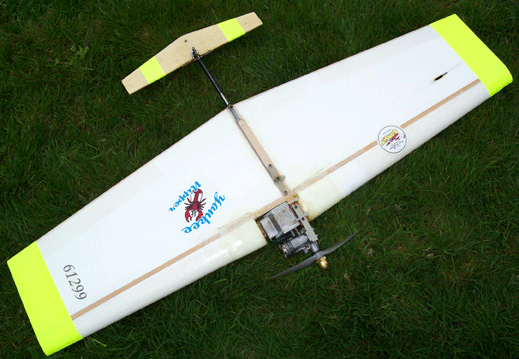
Howdy pardner. So you wanna' fly some combat, hunh?
Taking this from the beginning, let's assume that you are new to C/L, have flown enough to know that you are interested in it and have been to a contest and seen two pilots duking it out in the air. You've watched the other types of C/L competition but are for some unknown magical mysterious primal reason drawn to the combat circle. That's good and as one of our long time C/L leaders in the Northwest has said; "You are probably genetically pre-disposed to fly control line combat."
Experts, please don't flame me but I'd like to establish a solid groundwork
then advance to finer points of the art later. It is an
art form isn't it?
of the art later. It is an
art form isn't it?
OK, you might think this is funny but my favorite plane to sport fly right at the moment is a Fox .35-stunt powered East Coast-style speed limit (SL) plane called a "Yankee Nipper." The plane was designed by Jim Carpenter, who lives in New Hampshire. It is a popular design which is used, copied and flown at many 75 mph SL contests.
Probably not many pilots will be using a box stock Fox .35 stunt engine to fly but they do work for that purpose. In fact one of the advantages of using a Fox .35 is that you would have a hard time making it go too fast. The speed limit events are the most popular throughout the U.S. at this time and the name defines the event. At a 75 mph contest the planes are not allowed to go faster than 75 mph. The same would be true for an 80 mph contest.
For a little clarification, the AMA rules require any combat plane being flown in a match to have a working shutoff device if the speed of the model is above 75 mph.
Back to the basics; I'll try to stay on point. The focus of this article is to give my perspective on how I would suggest a new C/L pilot (newb) to prepare himself/herself for competing at combat.
1/2a model planes are THE best way to start flying C/L. They are inexpensive, easy to build and easy to repair. During the learning curve the new pilot will sometimes be surprised at how fast the ground can perform it's voodoo on the plane. Uh-oh, how did that happen? It is easier to repair or replace a little 1/2a than a full sized .35 plane. Why spend a bunch of dollars and a lot of hours building a full sized model only to stick it in the ground the first time you are attempting to fly inverted?
Let's say you've been hangin' around with one or more combat junkies, you/they have a place to fly and you've gone through the beginner stage of the learning curve. You know how to get in the air and fly level. You keep doing that until it gets boring. Hey, how about some maneuvers? Let's go first with a wing over. The thumb rule is to maneuver down wind. But let's break that rule right now by determining which way the wind is coming from and plan to enter the wingover from the upwind portion of the circle. Get comfortable, relax (that's RE and LAX). This is important, why tense up? This is supposed to be fun not work.
So you are flying level upright and know which way the wind is blowing from. You would begin to give up control a few feet prior to entering the windy area. Give just enough up to get the plane to point it's little nose up (it won't take much). As soon as the nose is pointed up, flex your wrist down enough to have the plane's direction continue straight up over your head. Hold that hand position and adjust your feet and body so as to be comfortable following the plane in it's arc back toward the ground on the downwind side of the circle. Now give some up input to get the plane to fly level again. Hey now! You've completed a wing over! Do a few more wing overs to get used to 'em. After gaining some confidence you will find that you will be able to enter and exit the wing over maneuver with some amount of precision.
One goal to set for yourself would be to learn the stunt pattern. Yes, it will be helpful for you to learn the "Pattern." We can talk about some of those maneuvers next time. Also, after you've got enough handle time under your belt to where you feel a little cocky you should start thinkin' about a larger model. This would be a good time to build a model like the "Yankee Nipper". The Nipper or something like it with a pokey engine on it would be a good choice for continued practice. Shortly you will be wanting to build some planes to take to your first contest.
That's enough to start with. Always remember: Be safe! Wear eye protection and wear hearing protection. Wear a finger guard when starting an engine. Even for starting the little 1/2a's.
This page was upated Aug. 8, 2006